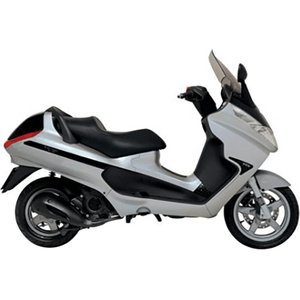Piaggio X8 150 [2005-2007] Review: A Practical Urban Companion Revisited
Introduction
The mid-2000s were a golden era for maxi-scooters, blending motorcycle-like practicality with the agility of urban two-wheelers. Among these, the Piaggio X8 150 stands out as a workhorse designed for city commuters who refuse to compromise on storage, comfort, or that faint whiff of Italian flair. Produced between 2005 and 2007, this scooter generation remains a fascinating study in balancing utility with everyday rideability. Having spent a week with a well-maintained example, here’s why the X8 150 still resonates with riders today—and where it leaves room for upgrades.
Design & Ergonomics: Form Follows Function
The Piaggio X8 150’s design screams “practicality first.” Its angular bodywork, dominated by sharp lines and a tall windscreen, gives it a bulkier presence compared to sleeker rivals. But this isn’t just aesthetics—the X8’s 160 kg (353 lbs) heft and 790 mm (31.1-inch) seat height translate into a commanding riding position. Taller riders will appreciate the legroom, though shorter pilots might find the seat height slightly intimidating at stops.
Storage is where the X8 shines. The underseat compartment swallows a full-face helmet with ease, and the flat floorboard offers space for grocery bags or a small pet carrier. The plastic panels feel durable but not premium—a reminder that this scooter was built for daily grind, not garage queens. Wind protection from the broad fairing is decent, though highway speeds reveal some buffeting around the shoulders.
Engine & Performance: City Slicker, Not Speed Demon
Powered by a 151 cc single-cylinder engine producing 11 PS (8.6 kW), the X8 150 isn’t about adrenaline rushes. Instead, it thrives in the 30–60 km/h (18–37 mph) zone where most urban riding happens. Throttle response is smooth, and the CVT transmission eliminates gear shifts—perfect for stop-and-go traffic. Top speed hovers around 90 km/h (56 mph), enough for brief highway stints, though overtaking requires patience.
Fuel efficiency is a strong suit. The 12.5-liter (3.3-gallon) tank delivers a 250–300 km (155–186 mi) range, depending on riding style. During my test ride, averaging 35 km/l (82 mpg), the X8 felt frugal without sacrificing usable power. The exhaust note is muted, blending into city noise—a pro for commuting, a con for enthusiasts craving character.
Ride Experience: Comfort Meets Compromise
Riding the X8 150 feels like piloting a compact SUV—stable but not sporty. The telescopic front forks and dual rear shocks handle potholes competently, though sharper bumps send jolts through the chassis. At low speeds, the weight is noticeable; U-turns demand careful countersteering. But once rolling, the scooter feels planted, even on rain-slicked roads.
Braking relies on a front disc and rear drum setup, adequate for the scooter’s pace. The DOT 4-compatible system offers decent bite, but panic stops require a firm squeeze. Upgrading to sintered pads (available at MOTOPARTS.store) would sharpen response. Cornering is cautious—the X8 prefers upright stability over lean angles, and the floorboard scrapes earlier than expected.
Competition: How the X8 Stacks Up
In the 150 cc scooter segment, the X8 150 faced stiff rivals:
- Honda SH150i: Lighter (148 kg / 326 lbs) and more nimble, the SH150i outperforms the X8 in fuel efficiency and handling. However, its storage and wind protection lag behind Piaggio’s offering.
- Yamaha Majesty 125: A smoother ride and lower seat height make the Majesty friendlier for beginners, but its 125 cc engine feels underwhelming next to the X8’s 151 cc.
- Suzuki Burgman 125: The Burgman’s premium styling and CVT refinement are wins, though its smaller engine and cramped storage lose to the X8’s practicality.
The Piaggio’s edge lies in its balance of power and utility. While rivals excel in specific areas, the X8 150 remains a jack-of-all-trades—ideal for riders prioritizing cargo space and relaxed commuting.
Maintenance: Keeping the X8 150 Rolling
Owning a 15+ year-old scooter demands attention to wear-prone components. Here’s what to watch:
- Oil Changes: Piaggio recommends fresh 10W-40 every 5,000 km (3,100 mi). Synthetic blends (available in our store) extend intervals and reduce engine chatter.
- Drive Belt: Inspect every 10,000 km (6,200 mi). Cracks or fraying? Swap it promptly—our reinforced aftermarket belts improve longevity.
- Brake Fluid: Flush DOT 4 fluid every 2 years. Spongy levers? Consider steel-braided lines for firmer feedback.
- Tires: The 160 kg weight eats through rubber. Upgrade to grippy, dual-compound tires for wet weather confidence.
Pro Tip: The X8’s carburetor can clog if left unused. For bikes in storage, add fuel stabilizer and crank the engine monthly.
Conclusion: A Legacy of Practicality
The Piaggio X8 150 isn’t about thrills—it’s about mastering the mundane with Italian pragmatism. For urban riders needing a dependable, storage-packed commuter, it remains a compelling choice. While newer scooters offer tech upgrades, the X8’s simplicity and ruggedness make it a favorite for DIY enthusiasts.
And that’s where MOTOPARTS.store shines. Whether you’re refreshing the suspension, upgrading brakes, or adding a top case, our catalog ensures your X8 150 stays relevant in 2024 and beyond. After all, why settle for stock when you can tailor your ride to outpace its legacy?
Ready to personalize your Piaggio X8 150? Explore our curated selection of parts and accessories here.



















